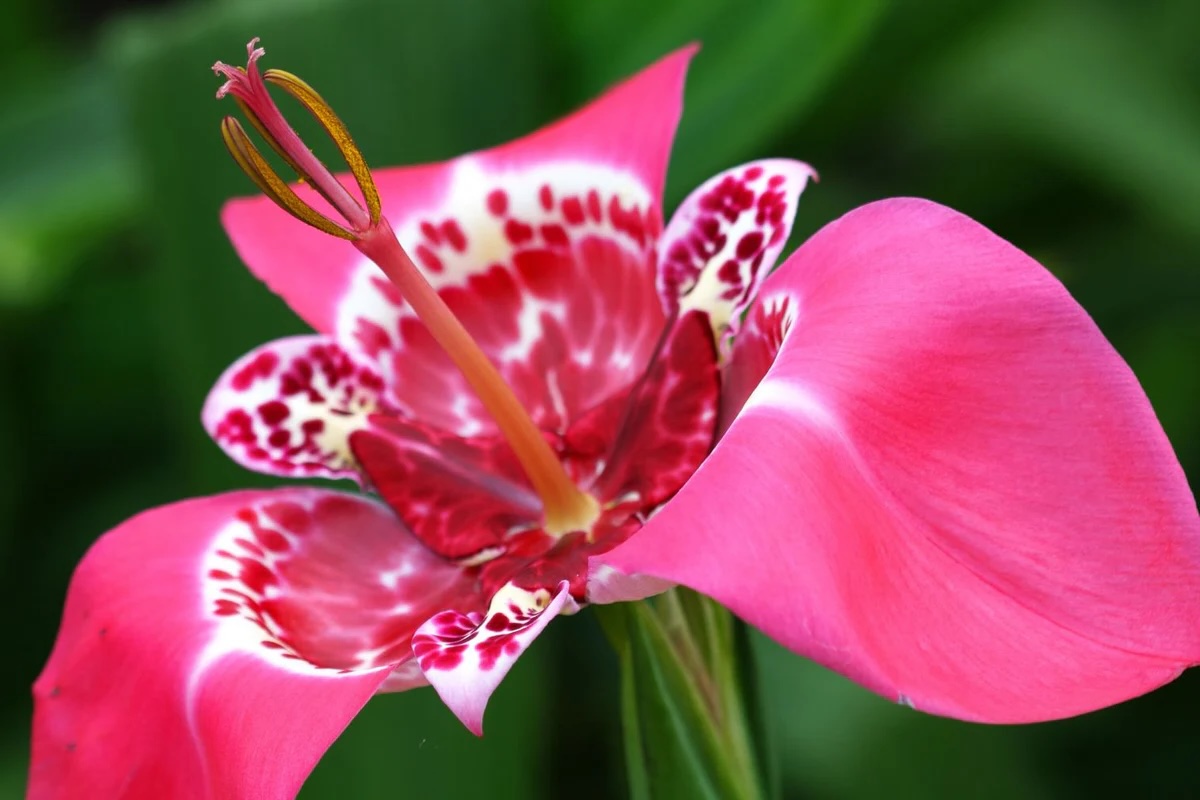
Tigridia, also known as the Tiger Flower or Jockey's Cap Lily, is a stunning and unique plant that captures the imagination with its vibrant colors and intricate patterns. Native to Mexico and Central America, this exotic bloom belongs to the Iridaceae family. Tigridia pavonia, the most well-known species, boasts large, eye-catching flowers that only last a single day but bloom in succession, ensuring a continuous display of beauty. These flowers thrive in well-drained soil and full sun, making them a favorite among gardeners. Did you know that Tigridia bulbs can be planted in spring for a summer spectacle? Their striking appearance isn't just for show; they also attract pollinators like bees and butterflies. Ready to learn more about this fascinating plant? Let's dive into 27 intriguing facts about Tigridia!
What is Tigridia?
Tigridia, also known as the Tiger Flower, is a stunning plant native to Mexico and Central America. Its vibrant colors and unique patterns make it a favorite among gardeners and flower enthusiasts.
- Tigridia pavonia is the most well-known species, often referred to as the peacock flower due to its eye-catching appearance.
- The name Tigridia comes from the Latin word for tiger, inspired by the flower's striking, tiger-like spots.
- These flowers belong to the Iridaceae family, which also includes irises and crocuses.
Unique Characteristics of Tigridia
Tigridia flowers are not just beautiful; they have several unique traits that set them apart from other plants.
- Each flower blooms for just one day, making every blossom a fleeting but spectacular event.
- Despite their short lifespan, a single plant can produce multiple flowers over the blooming season.
- The flowers come in a variety of colors, including red, yellow, pink, and white, often with contrasting spots.
Growing Tigridia
Interested in growing Tigridia in your garden? Here are some essential facts to help you get started.
- Tigridia prefers well-drained soil and a sunny location to thrive.
- These plants are typically grown from bulbs, which should be planted in the spring.
- They require moderate watering, ensuring the soil remains moist but not waterlogged.
Tigridia in History and Culture
Tigridia has a rich history and cultural significance, particularly in its native regions.
- The Aztecs valued Tigridia for its medicinal properties, using it to treat various ailments.
- In Mexico, the bulbs are sometimes used as a food source, similar to potatoes.
- Tigridia is often featured in traditional Mexican art, symbolizing beauty and the fleeting nature of life.
Tigridia and Wildlife
Tigridia flowers play an important role in their ecosystems, attracting various pollinators.
- These flowers are particularly attractive to hummingbirds, which are drawn to their bright colors.
- Bees and butterflies also frequent Tigridia blooms, aiding in pollination.
- The plants can help support local wildlife by providing a food source for these pollinators.
Fun Facts About Tigridia
Here are some additional fun facts that highlight the fascinating aspects of Tigridia.
- Tigridia flowers are sometimes called "Jockey's Cap Lilies" due to their unique shape.
- The plant's bulbs can survive mild frost, making them relatively hardy.
- Tigridia is often used in floral arrangements due to its striking appearance.
Tigridia in Modern Gardening
Modern gardeners have embraced Tigridia for its beauty and ease of care.
- These flowers are ideal for rock gardens and borders, adding a splash of color.
- Tigridia can be grown in containers, making them versatile for various garden settings.
- They are relatively pest-resistant, reducing the need for chemical treatments.
Tigridia Varieties
There are several varieties of Tigridia, each with its unique charm.
- Tigridia vanhouttei features deep red flowers with yellow spots.
- Tigridia conchiflora is known for its bright yellow blooms with red spots.
- Tigridia durangensis has delicate pink flowers with maroon spots.
Caring for Tigridia
Proper care ensures that Tigridia plants remain healthy and vibrant.
- After blooming, allow the foliage to die back naturally to help the bulbs store energy for the next season.
- In colder climates, bulbs should be dug up and stored indoors during winter to prevent frost damage.
- Regularly check for signs of disease or pests, such as yellowing leaves or holes in the foliage, and treat promptly.
Tigridia's beauty and unique characteristics make it a fascinating addition to any garden. Whether you're a seasoned gardener or a beginner, these facts will help you appreciate and care for this remarkable plant.
The Beauty and Mystery of Tigridia
Tigridia, also known as the Tiger Flower, is a stunning plant that brings a splash of color to any garden. With its vibrant petals and unique patterns, it’s no wonder this flower has captured the hearts of many. Originating from Mexico and Central America, Tigridia thrives in warm climates and well-drained soil. Its short-lived blooms open in the morning and close by evening, making each day a new surprise.
These flowers aren’t just pretty faces; they’re also pollinator magnets, attracting bees and butterflies. Planting Tigridia can add both beauty and biodiversity to your garden. Whether you’re a seasoned gardener or just starting out, this flower is a fantastic choice. So, next time you’re looking to add some flair to your garden, consider the Tiger Flower. It’s a small effort for a big reward.
Was this page helpful?
Our commitment to delivering trustworthy and engaging content is at the heart of what we do. Each fact on our site is contributed by real users like you, bringing a wealth of diverse insights and information. To ensure the highest standards of accuracy and reliability, our dedicated editors meticulously review each submission. This process guarantees that the facts we share are not only fascinating but also credible. Trust in our commitment to quality and authenticity as you explore and learn with us.
